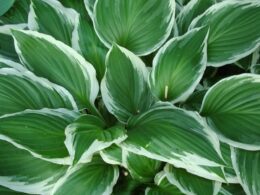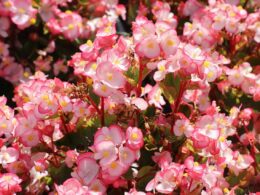Are you considering planting sage in your garden but wondering if it will come back every year? Sage is a popular herb known for its long history of medicinal and culinary uses, but it’s not always clear if it’s a perennial or an annual plant.
The good news is that sage is a hardy perennial plant that can live for several years with proper care and maintenance. In this article, we’ll explore the factors that affect sage’s longevity and provide tips for maintaining a healthy plant.
We’ll also discuss how to overwinter sage, so you can enjoy fresh herbs year after year. By the end of this article, you’ll have a better understanding of whether sage is the right choice for your garden and how to ensure its longevity.
So, let’s dive in and learn more about this versatile plant!
Understanding Sage as a Perennial Plant
So, if you’re thinking about adding this fragrant herb to your garden, it’s important to know that as a perennial plant, Sage will return year after year. This means that you won’t have to worry about planting new Sage every year, saving you time and effort in the long run.
Sage propagation is relatively easy, so you can even propagate your own Sage plants to expand your garden. Aside from being a low-maintenance plant, Sage also has many medicinal benefits. It has been used for centuries as a natural remedy for various ailments such as sore throat, digestive issues, and inflammation.
Sage tea is a popular way to consume the herb for its medicinal properties. With Sage readily available in your garden, you won’t have to spend money on store-bought remedies. Incorporating Sage into your garden not only adds a lovely fragrance but also provides many benefits.
With its perennial nature and medicinal properties, Sage is a valuable addition to any garden. So, go ahead and plant some Sage in your garden and enjoy its many benefits year after year.
Factors Affecting Sage’s Longevity
Understanding what affects the longevity of sage plants is crucial if you want to make them thrive for as long as possible. Sage is a perennial plant, which means it can survive for several years. However, the longevity of this plant depends on several factors.
Here are some things to keep in mind if you want your sage to last:
-
Growing conditions: Sage thrives in well-drained soil and full sun. You should also make sure to water it regularly, but not too much. Overwatering can lead to root rot, which can shorten the life of the plant.
-
Pest control: Sage is prone to several pests, including aphids, spider mites, and whiteflies. These insects can damage the plant and shorten its lifespan. To keep your sage healthy, you should regularly inspect it for pests and take appropriate measures to control them.
-
Climate: Sage is a hardy plant that can survive in a variety of climates. However, extreme weather conditions, such as drought or freezing temperatures, can damage the plant and shorten its lifespan. If you live in an area with harsh weather conditions, you may need to take extra precautions to protect your sage.
-
Pruning: Regular pruning is essential for maintaining the health and longevity of your sage plant. You should remove any dead or damaged branches, as well as any branches that are growing too close together. This will help to promote healthy growth and prevent disease.
By taking these factors into account, you can help to ensure that your sage plant lasts for as long as possible. With proper care and attention, your sage can provide you with fresh herbs year after year.
What Are Some Winter Care Tips for Sage Plants to Ensure They Come Back Every Year?
Keeping sage alive in winter requires proper care. Start by pruning the plant before winter to remove dead or damaged branches. Next, provide insulation by mulching the base with straw or leaves. Watering should be done adequately but avoid overwatering. Lastly, consider protecting sage from cold winds by placing it in a sheltered area or covering it with a frost blanket. Following these winter care tips will ensure that sage plants thrive and come back year after year.
Tips for Maintaining a Healthy Sage Plant
If you want to keep your sage plant healthy and thriving, there are three key areas to focus on:
-
Proper watering and drainage: Make sure you’re watering your sage plant deeply and consistently, allowing excess water to drain away.
-
Pruning and harvesting practices: Regular pruning and harvesting will encourage new growth and prevent the plant from becoming too woody.
-
Fertilization and soil amendments: Finally, fertilize your sage plant with a balanced plant food and amend the soil with organic matter to ensure it has everything it needs to flourish.
Remember to double check that each key area is being properly addressed to maintain a healthy sage plant.
Proper Watering and Drainage
You need to make sure your sage plant has proper watering and drainage if you want it to thrive and be healthy. Sage plants require well-draining soil that isn’t too wet or too dry.
Watering frequency depends on the climate, humidity, and soil type. In general, sage plants need to be watered deeply once a week during the growing season and less frequently during the dormant season. However, it’s important to monitor the soil moisture level by sticking your finger into the soil to check if it’s damp or dry.
Overwatering can lead to root rot, which can kill your sage plant. To avoid this, make sure the pot has drainage holes and excess water can drain away from the roots. If you’re planting sage in the ground, ensure the soil is well-draining by adding sand or gravel to improve drainage.
You can also mulch around the base of the plant to retain moisture and prevent weeds from growing. By giving your sage plant the right amount of water and good drainage, you can enjoy a healthy and thriving herb garden.
Pruning and Harvesting Practices
To keep your sage plant healthy and productive, it’s important to regularly prune and harvest its leaves.
Pruning techniques can vary depending on the size and growth pattern of your plant. If your sage is getting too tall and leggy, you can trim back the top growth to encourage bushier growth. You can also prune the plant back by a third in the spring to promote new growth. Be sure to use sharp, clean pruning shears to prevent damage to the plant.
Harvesting methods are also important for maintaining a healthy sage plant. It’s best to wait until the plant is at least six inches tall before harvesting any leaves. When harvesting, be sure to only take a few leaves from each stem, leaving enough to allow the plant to continue to grow and produce. You can also cut the entire plant back by one-third to one-half in the fall to promote new growth and prevent woody stems.
By following proper pruning and harvesting techniques, you can ensure your sage plant will continue to thrive and provide fresh, flavorful leaves for years to come.
Fertilization and Soil Amendments
Proper fertilization and soil amendments are essential for maintaining the health and vitality of your sage plant. It’s important to conduct a soil test before planting to determine the pH and nutrient levels of your soil.
Sage thrives in well-draining soil with a pH between 6.0-7.0. If your soil is too acidic or alkaline, you may need to add amendments such as lime or sulfur to adjust the pH.
Organic fertilizers such as compost, manure, and fish emulsion are great options for feeding your sage plant. These types of fertilizers provide essential nutrients without the risk of burning the plant. Apply fertilizer in the spring and summer months, avoiding fertilization during the winter when the plant is dormant.
With proper fertilization and soil amendments, your sage plant will be able to thrive and come back year after year.
How to Overwinter Sage
If you want to keep your sage plant healthy during the winter months, there are a few things you can do to prepare it for the colder weather.
First, you’ll want to trim back any dead or diseased leaves and branches.
Next, you can protect your sage from frost and cold temperatures by covering it with a cloth or blanket.
Finally, when spring arrives, you can rejuvenate your sage plant by pruning it back and giving it a fresh start for the new growing season.
Preparing Sage for Winter
You can ensure the survival of your sage plant during the winter by taking proper precautions and providing the necessary care. Here are some tips that can help:
-
Trim the plant: Before the winter season arrives, it’s important to trim your sage plant. This will help the plant conserve energy and focus on growth in the spring.
-
Mulching: Mulching is an effective technique that helps protect your sage plant from the harsh winter weather. Cover the base of the plant with a thick layer of mulch to keep the roots warm and protect them from frost.
-
Watering: Sage plants need less water during the winter season, so make sure you water them only when the soil is dry. Overwatering can lead to root rot and damage the plant.
-
Winter storage: If you live in an area with extremely cold winters, you can consider storing your sage plant indoors. Keep it in a sunny area and make sure to water it regularly.
By taking these simple steps, you can ensure that your sage plant will survive the winter season and come back stronger in the spring. Remember to check on your plant regularly and make adjustments as needed.
Protecting Sage from Frost and Cold Temperatures
Protecting your sage plant from frost and cold temperatures is essential for its survival during the winter season. Winterizing and covering your sage will help to insulate it from the cold and prevent damage to the delicate leaves.
One way to winterize your sage is to mulch around the base of the plant with a layer of straw or leaves. This will help to keep the roots warm and prevent them from freezing.
Another way to protect your sage is to cover it with a cloth or blanket on particularly cold nights. Be sure to remove the cover in the morning to allow the plant to receive sunlight and air.
Aside from its use in cooking, sage is also known for its medicinal properties. It can be used as a natural remedy for sore throats, digestive issues, and even memory loss.
Protecting your sage during the winter will ensure that you have a healthy plant to use for both culinary and medicinal purposes. So, take the necessary steps to protect your sage and enjoy its benefits all year round.
Rejuvenating Sage in Spring
After a long winter, it’s time to revitalize your sage plant in preparation for the upcoming growing season. Giving your sage a little extra care now will help ensure it comes back strong and healthy year after year.
Sage is a hardy herb that offers many benefits. Not only is it a beautiful addition to any garden, but it also has medicinal properties and culinary uses.
To rejuvenate your sage in the spring, start by pruning away any dead or damaged branches. This will encourage new growth and help prevent disease. Next, give your sage a good watering and apply a layer of compost or fertilizer to the soil. This will provide it with the nutrients it needs to thrive.
With a little bit of care, your sage will be ready to use in all your favorite recipes in no time. So go ahead and take care of your sage plant – you won’t regret it!
Conclusion and Takeaways
So, if you’re looking for a low maintenance herb to add to your garden, this perennial option might be just what you need to enjoy fresh, flavorful sage year after year. Sage is a hardy plant that requires minimal care, making it an ideal choice for those who don’t have a lot of time or energy to devote to gardening. By following a few simple tips, such as pruning and fertilizing, you can ensure that your sage plant thrives and returns every year.
Key takeaways from our discussion on rejuvenating sage in spring include the importance of pruning back the plant in order to encourage healthy growth, fertilizing regularly to provide essential nutrients, and keeping an eye out for signs of disease or pests. By taking these steps, you can help your sage plant to stay healthy and strong, ensuring that it will continue to provide you with fresh, flavorful leaves for years to come.
In conclusion, while there are no guarantees in gardening, sage is a perennial herb that is known for its ability to return year after year. By providing it with the proper care and attention, you can enjoy a bountiful harvest of flavorful leaves that will add a delicious touch to your favorite dishes. So why not give it a try and see for yourself how easy it can be to grow this versatile herb?
Frequently Asked Questions
What are some common pests and diseases that affect sage plants?
To keep your sage plants healthy and thriving, it’s important to be aware of common pests and diseases that can affect them. Preventing infestations is key, and there are several natural remedies for sage pests, such as using neem oil or planting companion plants like marigolds.
Keep an eye out for signs of sage plant diseases, such as wilting or yellowing leaves, and consider treatment options like removing infected parts of the plant or using fungicides.
By staying vigilant and taking proactive measures, you can help ensure that your sage plants stay strong and resilient year after year.
Can sage be grown indoors?
If you’re looking to grow sage indoors, container gardening is the way to go. Indoor growing allows you to control the environment in which your sage plant grows, ensuring it gets the proper amount of sunlight and water.
Choose a container that is at least 6-8 inches deep and fill it with a well-draining soil mix. Sage plants need at least 6 hours of sunlight a day, so place your container near a sunny window or under grow lights.
Water your sage plant when the top inch of soil feels dry to the touch. With proper care, your sage plant can thrive indoors and provide you with fresh herbs year-round. So, whether you’re looking to add some flavor to your meals or want to enjoy the health benefits of sage, indoor growing is a great option.
Is it necessary to prune sage plants?
To prune or not to prune: that’s the Sage maintenance debate. While some gardeners swear by regular pruning to keep their Sage plants manageable, others argue that allowing the plant to grow freely produces a better yield.
It’s important to understand how pruning affects growth before making a decision. Regular pruning can help keep Sage plants from becoming too large and leggy, but it can also stunt growth and reduce the amount of leaves produced.
Ultimately, the decision to prune or not to prune depends on your personal preferences and the specific needs of your Sage plant. Keep in mind that Sage is a hardy perennial that will come back year after year, whether or not you choose to prune it.
How long does it take for sage plants to mature?
Sage plants typically take 2-3 years to reach maturity, depending on the growing conditions. It’s important to provide them with well-draining soil and plenty of sunlight.
Once mature, you can harvest the leaves as needed by clipping them from the stem. To encourage new growth, it’s recommended to prune sage plants regularly.
While sage is a hardy perennial, it’s important to protect it from harsh winter conditions. Covering the plant with a layer of mulch can help ensure its survival.
With proper care and harvesting techniques, your sage plant can provide flavorful leaves for years to come.
Are there different varieties of sage that have different growing requirements?
If you’re planning on growing sage, it’s important to know that there are different varieties of sage that have different growing requirements. Some varieties are more drought-tolerant, while others prefer more moisture. Additionally, some varieties may require more sunlight than others.
It’s important to do your research and choose a variety that will thrive in your specific growing conditions. With the right care and attention, sage plants can live for several years and will come back every year.
Conclusion
So, will your sage plant come back every year? The answer is yes, as long as you take good care of it.
Sage is a perennial plant, which means that it can live for more than two years. However, its longevity depends on various factors such as the climate, soil, and maintenance practices.
To ensure that your sage plant lives a long and healthy life, it’s important to provide it with the right growing conditions. This includes planting it in well-draining soil, giving it enough sunlight, and watering it regularly. You should also prune it regularly to promote new growth and prevent disease.
If you live in an area with harsh winters, you can overwinter your sage plant by bringing it indoors or covering it with a protective layer of mulch.
By following these tips and taking good care of your sage plant, you can enjoy its aromatic leaves and medicinal properties for many years to come.








